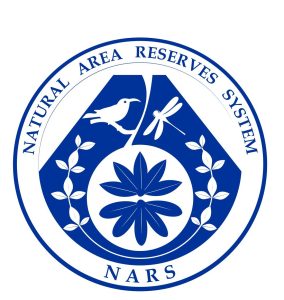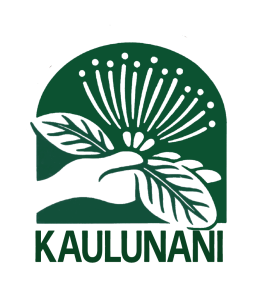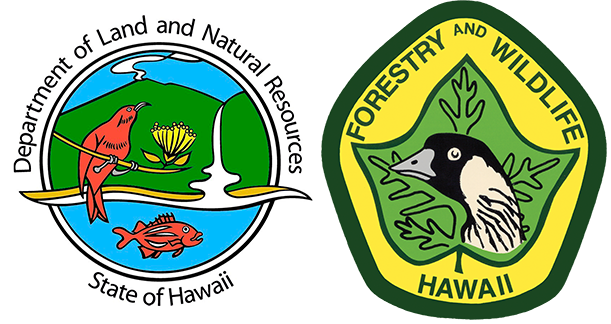Happy Anniversary to Forestry & Wildlife and You!

We have a lot to celebrate with you
2023 marks a number of important anniversaries for Hawaiʻi’s forests and conservation programs. Click below to visit the website of each program and learn more about their work. Read below for the story of the Division of Forestry and Wildlife, or jump lower on this page to explore historical photos and find additional 2023 anniversaries for Natural Area Reserves, Kaulunani, Nā Ala Hele, and more.
120 Years: The Division of Forestry & Wildlife
 Our division began with the Forestry Act of 1903, which created the Board of Agriculture and Forestry and established the Forest Reserves System. Then called the Division of Forestry, early work focused on establishing reserves for the protection of water resources. Landscapes denuded by invasive ungulates were reforested through intensive efforts in the early 1900s, including work done by the Civilian Conservation Corps. Some of the goals and functions of that era remain today, including a focus on outplanting and fencing, and an understanding that forests are our only source of fresh water. Some practices have changed, in particular the use of fast-growing, non-native plant species in forest restoration. As our understanding of ecology and invasive species has changed over the years since the early 1900s, so to have our management practices.
Our division began with the Forestry Act of 1903, which created the Board of Agriculture and Forestry and established the Forest Reserves System. Then called the Division of Forestry, early work focused on establishing reserves for the protection of water resources. Landscapes denuded by invasive ungulates were reforested through intensive efforts in the early 1900s, including work done by the Civilian Conservation Corps. Some of the goals and functions of that era remain today, including a focus on outplanting and fencing, and an understanding that forests are our only source of fresh water. Some practices have changed, in particular the use of fast-growing, non-native plant species in forest restoration. As our understanding of ecology and invasive species has changed over the years since the early 1900s, so to have our management practices.
The Division of Forestry has gone through many organizational changes. In 1960 it became part of the Department of Agriculture and Conservation, and in 1961 was transferred to the new Department of Land and Natural Resources. In 1970 the Natural Area Reserves Commission was established, which is now part of the division’s Native Ecosystems Protection and Management Program. In 1979 the recreational hunting duties that were previously associated with the Division of Fish and Game were merged with forestry, changing the division’s name to the Division of Forestry & Wildlife and becoming part of the division’s Wildlife Program. You can read more about the Division of Fish and Game in this history prepared by Ron Walker. In 1988, additional recreation duties were added to the division with the establishment of the Nā Ala Hele Trails & Access Program. This program oversees a vast network of public trails in Hawaiʻi for hiking, biking, and in some cases equestrian access, and manages information about historical trails.
Today’s Division of Forestry and Wildlife manages over one million acres of public lands and addresses a variety of public-use goals. Our staff are people who love nature and have the honor and responsibility of managing natural and cultural resources on behalf of the people of Hawaiʻi. To learn more:
- Visit our About Us page to meet our team, and watch staff profile videos describing their roles and why they care about protecting Hawaiʻi’s natural and cultural resources
- Visit our Lands & Management page to explore the one million acres we management and understand our multiple public-use goals, including conservation and vegetation management, forest products management, hunting and other recreational management
- Visit our Education page to meet the native species we protect, explore key conservation concepts through engaging StoryMaps, watch videos and documentaries about our work, and even take virtual field trips to our remote project sites.
From the staff of Forestry & Wildlife, mahalo for the opportunity to serve our ʻāina alongside you. We look forward to continuing our work toward our vision: a future with thriving native ecosystems and opportunities for the people of Hawaiʻi to engage with nature.
Historical Photos
Click on an album below to see photos.
More to celebrate
In addition to 120 years of Forestry & Wildlife, several of our programs have important anniversaries in 2023. Click any program below to visit its website and learn more.

50 Years: 1st Natural Area Reserve at ʻĀhihi-Kīnaʻu
The Natural Area Reserves Commission was established in 1970, and their first reserve was established in 1973 at ʻĀhihi-Kīnaʻu on Maui. ʻĀhihi-Kīnaʻu remains unique among the over 20 Natural Area Reserves we manage today, as it is the only reserve that includes a marine area. In fact, it includes the healthiest coral reef in Hawaiʻi. It also includes incredible anchialine pools dotted across a windswept landscape of lava rock, and is home to native seabirds. Learn more about the Natural Area Reserves System, take a quick statewide tour of the Natural Area Reserves, or dive into our first reserve, ʻĀhihi-Kīnaʻu.

35 Years: Nā Ala Hele Trails & Access Program
Nā Ala Hele is the State of Hawai‘i Trail and Access Program, created to manage public resources related to hiking. The program manages trail access and conducts trail maintenance in order to provide important public services including recreational opportunities, experiences related to cultural history and historic trails, and economic opportunities where possible for commercial trail vendors. Nā Ala Hele trails are also important for access into natural areas for management, research, hunting, and wildfire response. Visit the Nā Ala Hele webpages to learn more and explore trails across Hawaiʻi.

30 Years: Kaulunani Urban & Community Forestry
Kaulunani is proud to be the State of Hawaii’s Urban and Community Forestry Program housed within the Department of Land and Natural Resources’ (DLNR) Division of Forestry and Wildlife. Kaulunani focuses on improving the health and viability of trees in Hawaii’s communities through the implementation of educational programs; supporting Tree City USA communities across the state; providing technical training; administering financial support in the form of cost-share grants via Kaulunani’s Grant Program; supporting Arbor Day Hawaiʻi; and maintaining public/private partnerships. Visit the Kaulunani webpages to learn more.

20 Years: The Hawaiʻi Invasive Species Council
The Hawaii Invasive Species Council is an interagency collaboration created to address policy-level direction, coordination and planning on invasive species issues in Hawaiʻi. Though it is administratively housed with the Division of Forestry and Wildlife, the council’s voting membership is comprised of the heads or designees of the Departments of Land & Natural Resources (DLNR), Agriculture (DOA), Health (DOH), Transportation (DOT), Business, Economic Development & Tourism (DBEDT), and the University of Hawaii (UH). The HISC fulfills its mandate by issuing resolutions, providing plans, and strategically disbursing funds to enhance invasive species prevention, control, outreach, and research. Visit the HISC website to learn more.

20 Years: The Kauaʻi Endangered Bird Recovery Team
The Kauaʻi Endangered Bird Recovery Team was established in 2003 by Tom Savre. The project focused on protecting puaiohi in Kauaʻi’s forests and Newell’s shearwaters along the coast. In 2006 the project split to become the Kauaʻi Forest Bird Recovery Project and the Kauaʻi Endangered Seabird Recovery Project. This field photo shows Tom Savre at the weatherport on Halepaʻakai Stream in 2003.

20 Years: The Plant Extinction Prevention Program
The Plant Extinction Prevention Program protects about half of the 423 Threatened and Endangered plant species in Hawaiʻi. In Hawaiʻi, over 250 native plant species have fewer than 50 wild individuals remaining. This program is a partnership of the Pacific Cooperative Studies Unit at the University of Hawaiʻi and the Rare Plant Program at Forestry and Wildlife, along with state, federal, and private contributions. Visit the PEPP website to learn more.









